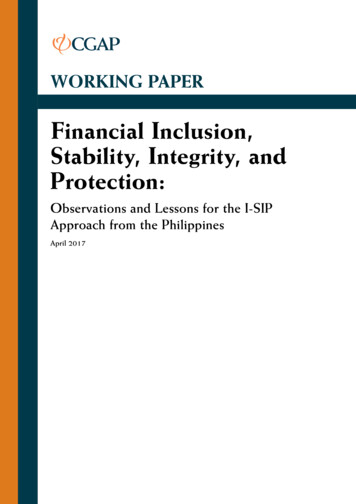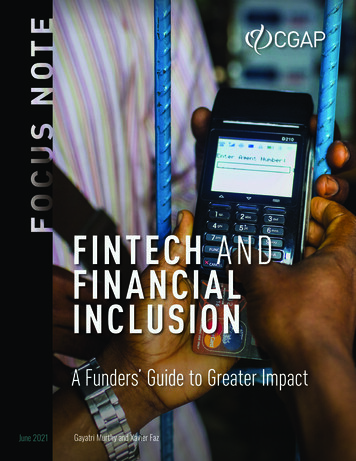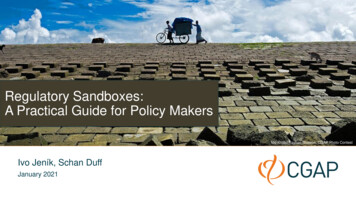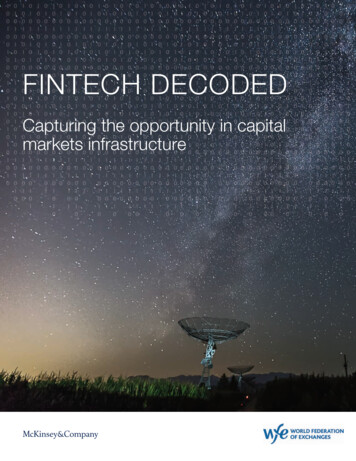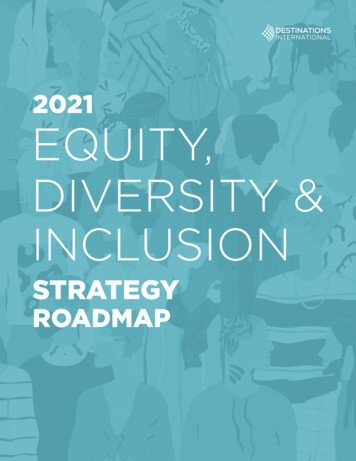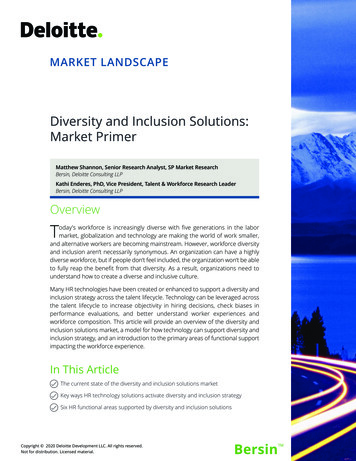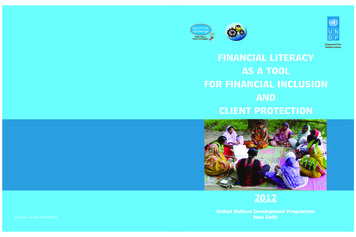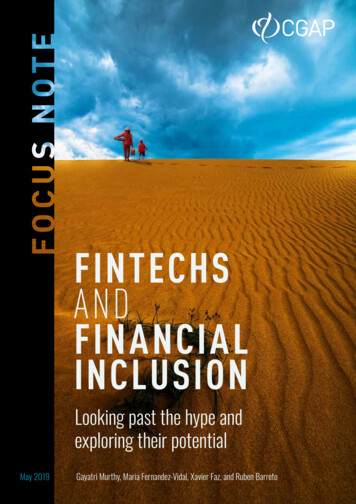
Transcription
1FINTECHSANDFINANCIALINCLUSIONLooking past the hype andexploring their potentialMay 2019FOCUS NOTE May 2019Gayatri Murthy, Maria Fernandez-Vidal, Xavier Faz, and Ruben Barreto
ACKNOWLEDGMENTSThe authors thank the 18 fintechs and their staff referenced in this paper. The insightspresented in this paper are gleaned from their experiences of bringing their innovativeservices to market. We also thank their customers who shared their time and their viewswith us. Lauren Braniff, Jayshree Venkatesan, and Fernando Barbon, all financial sectorspecialists and CGAP consultants, contributed to the insights presented in this paper.We are also thankful to the Busara Center for Behavioral Economics for its intellectualpartnership and contributions to this paper. We’d like to thank the Department forInternational Development (DFID), United Kingdom, and the Mastercard Foundation forfunding for the fintech pilots and associated work discussed in this report.Consultative Group to Assist the Poor1818 H Street NW, MSN IS7-700Washington DC 20433Internet: www.cgap.orgEmail: cgap@worldbank.orgTelephone: 1 202 473 9594Cover photo by Hung Dao Tran, CGAP Photo Contest.RIGHTS AND PERMISSIONSThis work is available under the Creative Commons Attribution 4.0 International PublicLicense (https://creativecommons.org/licenses/by/4.0/). Under the Creative CommonsAttribution license, you are free to copy, distribute, transmit, and adapt this work, including forcommercial purposes, under the following conditions:Attribution—Cite the work as follows: Murthy, Gayatri, Maria Fernandez-Vidal, Xavier Faz, andRuben Barreto. 2019. “Fintechs and Financial Inclusion.” Washington, D.C.: CGAP.Translations—If you create a translation of this work, add the following disclaimer along withthe attribution: This translation was not created by CGAP/World Bank and should not beconsidered an official translation. CGAP/World Bank shall not be liable for any content orerror in this translation.Adaptations—If you create an adaptation of this work, please add the following disclaimeralong with the attribution: This is an adaptation of an original work by CGAP/World Bank.Views and opinions expressed in the adaptation are the sole responsibility of the author orauthors of the adaptation and are not endorsed by CGAP/World Bank.All queries on rights and licenses should be addressed to CGAP Publications, 1818 H Street,NW, MSN IS7-700, Washington, DC 20433 USA; e-mail: cgap@worldbank.org
CONTENTSIntroductionSection 1: Emerging innovation areas11Innovation 1: Interactive Customer Engagement11Innovation 2: Smartphone-Based Payments15Innovation 3: Connections-Based Finance19Innovation 4: Location-Based Smallholder Finance21Innovation 5: De-Risking Unproductive Expenses24Section 2: Fintechs as catalysts for financial inclusionFOCUS NOTE528Internal challenges28External challenges37Conclusion40References41 May 2019
1E XECUTIVE SUMMARYFINTECH COMPANIES COMBINE TECHNOLOGY WITH ACCESS TOdata to deliver new financial services and experiences to customers. They havebeen proliferating in emerging markets and developing economies (EMDEs), andsome are creating solutions specifically for underserved, low-income, or remotecustomers. Yet for all the general excitement that fintechs have generated inthe global development community, there is little information available about how specificfintech innovations solve pain points in financial inclusion.In 2016, CGAP launched a program to understand fintech innovations and draw clear links tofinancial inclusion, where they existed. We supported pilots with 18 fintechs in Africa and SouthAsia that targeted financial services to low-income or underserved customers. Our goal was toexplain innovations in a detailed way and generate insight on whether the services (i) work asstated, (ii) create value for underserved customers, and (iii) ease age-old pain points in deliveringfinancial services to underserved customers.This paper is written for funders—whether donors, investors, development finance institutions,or philanthropic organizations—who engage with fintechs to advance financial inclusion. Basedon CGAP’s work, it identifies five types of fintech innovation that offer potential for financialinclusion. We also highlight challenges that these fintechs, particularly those in early stages, facethat inhibit their ability to impact financial inclusion.Key FindingsF I N T E C H S A R E B R I N G I N G I N N O VAT I O NT O E V E R Y PA R T O F T H E F I N A N C I A L S E R V I C E S S E C T O RThe excitement around fintech is not without merit. Fintechs are innovating at every stepof the financial services value chain, often through new value propositions, includingflexible products and better ways to address the financial challenges faced by low-incomecustomers. They are making financial services more affordable and accessible. Theyare improving the customer experience of financial services and accelerating use andengagement. They are also building the groundwork—including easier digital identityverification, collaborative customer due diligence, data sharing, and payment schemes—that can catalyze a host of financial services.FOCUS NOT E May 2019
2F I V E I N N O VAT I O N A R E A S D I S P L AY T H E P O T E N T I A LF O R F I N T E C H S T O I M PA C T F I N A N C I A L I N C L U S I O NThe following list is not an exhaustive set of innovations in the fintech space, but eachrepresents a powerful idea for financial inclusion. While most focus on payments and credittoday, we expect there will be a diverse array of products in the future, as providers capturemore data about their customers and are able to provide other services at marginal cost:Interactive customer engagement. Fintechs are using SMS and other communicationtools to reduce the cost and effort of engaging with customers. These tools ease complaintresolution, feedback gathering, and information dissemination. The result is greater use,trust, and loyalty. See Table ES1.TABLE ES1.Interactive customer engagement pilotsFintechServiceJuntosMobile messaging and customer serviceArifuMobile advice and informationPeople’s Pension TrustMobile nudges and incentives to encourage long-term savingsSmartphone-based payments. Fintechs are delivering intuitive, engaging smartphonebased payments applications with low data costs and low storage requirements. Thesesolutions are reducing account dormancy and expanding use cases for payments. SeeTable ES2.TABLE ES2.Smartphone-based payments pilotsFintechServiceWave MoneyPayments appNALA and HoverPayments app with no data requirementsFunduP2P ATM appConnections-based finance. Fintechs are creating or leveraging social connections tobuild customer creditworthiness and offer connections-based finance for low-income peoplewho cannot easily access cheap, timely credit to bridge cash-flow gaps. See Table ES3.TABLE ES3.Connections-based finance pilotsFintechServiceM-ChangaDigital crowd-funding siteMaTontineDigital savings groups and credit advancePezeshaDigital P2P lendingPatasenteDigital lending marketplace for MSMEsSocial LenderSocial-score-based lendingFINTECHS A ND FIN A NCI A L INCLUSION Executive Summary
3Location-based finance. Fintechs are using satellite data and machine-learningtechniques to analyze physical location and offer insurance or credit at reduced cost tosmallholders, who are some of the world’s most excluded groups. See Table ES4.TABLE ES4.Location-based finance pilotsFintechServiceFarmdriveDigital loans for farmersApolloDigital loans for farmersPulaSatellite data-based digital insuranceDe-risked nonproductive finance. Fintechs are helping low-income people pay sizableor unexpected expenses while using unique features to reduce risk for the financier. SeeTable ES5.TABLE ES5.De-risked nonproductive finance pilotsFintechServiceMicroensureDigital health insurance bundled with microcreditTulaaDigital credit for farm inputsBioliteEnergy products on creditF U N D E R S H AV E A R O L E T O P L AYIN S UPP OR T IN G E A R LY-S TA G E F IN T ECHSThe funding that reaches EMDEs primarily goes to more established fintechs that haveproven their business models. Without support from “angel” investors, many early-stagefintechs struggle even though they may have potentially game-changing ideas. Supportingthese fintechs could unlock innovation and produce relevant lessons for the entire financialservices market.However, because their business models are unproven, they may be too risky for privatecapital. Global development and impact investing communities can invest patient capital,but they may need to take the following steps: Bring clarity to a crowded marketplace of ideas. Fintech innovation is varied, andbecause much of it is new, there is a lack of universal understanding of new businessmodels and their potential to scale. Link solutions to financial inclusion. There are too few metrics for success andimpact on financial inclusion goals. Extract lessons from successes and failures. Global lessons about how fintechsattempt to resolve pain points in financial inclusion would provide a realistic sense offintechs’ effects on financial inclusion.FOCUS NOTE May 2019
4F I N T E C H S FA C E A U N I V E R S A L S E T O F I N T E R N A L C H A L L E N G E SFunders should be aware that all fintechs must overcome one or more of these four internalchallenges, particularly during early-stage innovation: Develop a clear value proposition. Since financial services for the poor are scarce inemerging markets and competition is low, fintechs often fail to invest enough time to testand articulate their value before launching services. Assemble the right human and technological resources. Having all three coreskills and resources—technology, market insight, and leadership—can be rare for startups in emerging markets. Balance digital and in-person customer interaction. Ensure underservedcustomers are comfortable using unfamiliar services or technologies that may requirein-person interactions. However, a business model that relies heavily on physicalinteractions through stores and agents may limit the ability to scale. Form strategic partnerships. Many early-stage fintechs depend on partnerships toget their ideas off the ground, either because they lack scale, capabilities, or adequatelicensing. However, their newness and size may make it difficult for them to forgeequitable partnerships with established institutions.ConclusionAfter two years of experimentation, we see preliminary evidence that fintechs have thepotential to affect financial inclusion, but more granular research is needed. Going forward,CGAP will support the global development sector, policy makers, and the impact investingindustry by facilitating a common understanding of emerging business models in fintechthat have the potential to advance financial inclusion. We will also extract granular lessonsfrom fintech innovations that can shed light on what creates value for the poor and on thelimitations of new approaches.FINTECHS A ND FIN A NCI A L INCLUSION Executive Summary
5INTRODUCTIONANEW SET OF TECHNOLOGY-BASED COMPANIES AREdisrupting the financial services market globally. Fintechs, as they are called,have developed a market presence in the decade since the 2008 financialcrisis. They have garnered attention because they combine technology withaccess to alternative data and innovative approaches to deliver new kinds offinancial products, services, and experiences to their customers. They have challengedbusiness-as-usual by being nimbler, serving underserved segments, or improving uniteconomics. Their success is reflected in the number of customers that adopt their servicesand how they influence established financial institutions to compete with more innovationand more customer-centric features and services (PWC 2017).Fintechs often begin as start-ups, but many have scaled dramatically. SoFi, a creditmarketplace founded in 2011 to offer digital, unsecured loans had issued more thanUS 9 billion in loans by 2016 and expanded to offer personal finance, billing, payments,insurance, and even pensions (CNBC 2016). Robo-adviser Betterment uses big data toreduce the cost of investing for a large base of U.S. customers.1 It charges customersjust 0.25 percent of their assets every year and does not require a minimum balance—alloffered through a user-friendly, interactive interface. After 10 years, Betterment managesUS 13 billion in investments.Some fintechsare creating solutionsspecifically designedfor underservedlow-income customers.Until recently, the fintech phenomenon was largely limited todeveloped markets. Now, fintechs are beginning to disruptthe financial ecosystem in emerging markets and developingeconomies (EMDEs) as well. While most solutions globallystill focus on affluent customers who are well served byfinancial services, some fintechs are creating solutionsspecifically designed for underserved low-income customers.The rise of fintechs such as PayTM, Zoona, Jumo, andCellulant in EMDE markets inspired CGAP to study them tounderstand their potential effects on financial inclusion.Fintech innovation and the role of fintech firmsFintechs are not alone in using technology to innovate. The term “fintech innovation” refersto activities by a broad range of actors, including incumbent financial institutions, and others.In fact, established financial institutions (e.g., banks, credit card companies) around theworld are using innovative technologies for improving everything from customer complaint1FOCUS NOTERobo-advisers provide financial advice or Investment management online with moderate to minimalhuman intervention. They provide digital financial advice based on mathematical rules or algorithms May 2019
6resolutions to fraud control. When innovation is combined with an established institution’sscale, brand recognition, and trust, the potential for impact can be high. In practice, however,adopting innovation has proven to be challenging for established organizations. Legacy ITsystems, heavy operational processes that are difficult to change, and a business model thatrelies on physical infrastructure make the cost of transformation high and limits the potentialfor reaching underserved segments. Nevertheless, Equity Bank in Kenya, Capitec in SouthAfrica, and DigiBank in South East Asia are examples of established financial institutions thatuse innovative technologies to grow and expand their offering in emerging markets.2On the other hand, fintechs typically begin as small firms with an innovation culture. Theirsize and newness give them the agility to change and develop infrastructure built fordigital operations. They have a consumer-centric perspective that is frequently lacking intraditional finance. Their survival depends on their effectiveness in bringing an innovationto market. Therefore, fintechs can be a driver of competition, diversification of financialservices offering, and efficiencies in markets.A quick look at the kinds of innovations brought by fintechs reveals another distinction fromtraditional finance institutions. Fintechs often focus on needs not addressed by incumbentsin the markets they operate in, and therefore they tackle pain points for underserved groups(e.g., those without credit scores or those who have a history of default) or groups that aredissatisfied with current products (e.g., millennials). In emerging markets, fintech offeringsoften align with financial inclusion goals.Despite the distinct effect fintechs could have in markets through new technologies andapproaches, they often need to partner with established financial institutions to scale.Some question whether the numerous and often narrow solutions brought about byfintechs could have substantive and cohesive impact. Because of the large number ofcompanies and business models emerging, it’s difficult to assess which are most usefulfor financial inclusion. Nonetheless, through their iterations, these companies may opendoors that have been closed to some customers. The success of a substantial mass offintechs could influence established financial institutions to adopt more efficient approaches,broaden the markets they serve, and become more responsive to customer pain points.Fintech catalysts in EMDEs are uniqueIn developed markets, fintechs benefit from widespread internet access, savvy digitalcustomers, and prevalence of digital money. EMDEs generally lack these conditions, butfintechs have still managed to do well in several EMDE countries. Some of the followingfactors may explain why: Widespread digital payment schemes have created an enabling infrastructure to bringnew businesses to market. Third-party integration mechanisms have made it easier for innovation to reach customers. Rising smartphone penetration has improved customer experience. New data sources have enhanced delivery and reduced costs to serve. Regulatory sandboxes are beginning to enable safe experimentation.2 In fact, even governments, most notably the Indian government, have used technology to offer digitalsolutions that enhance the entire national financial services architecture.FINTECHS A ND FIN A NCI A L INCLUSION Introduction
7W I D E S P R E A D D I G I TA L PAY M E N T S C H E M E SIn the past decade, many emerging markets have adopted regulations that allow newentrants into the financial services sector, especially in payments. These new players rangefrom mobile network operators (MNOs) and electronic money issuers that offer store-ofvalue accounts and payments services accessible from any mobile phone. MNOs attractvast numbers of agents that conduct cash-in and cash-out functions on behalf of mobilemoney providers and aggregators that facilitate the integration with mobile money platforms.Fintechs have used this infrastructure to target customers (i.e., business-to-consumerservices) or to conduct operations on behalf of large financial institutions (i.e., business-tobusiness services).T H I R D -PA R T Y I N T E G R AT I O N M E C H A N I S M SBanks and MNOs want to increase their customer base, build deeper customer loyalty,and expand use cases for digital transactions, and this has fueled interest to integrate withfintechs offering a variety of new services.3 MNOs have enjoyed a growing mobile moneybusiness, but in many markets, this is somewhat stagnant. Most transactions are focusedon cash-in and cash-out, person-to-person (P2P) payments, and airtime top-ups (GSMA2018). Unless MNOs reach scale and partner with new actors to drive up digital transactions,research suggests that the unit profit of mobile money from these services will not justifyunderlying investments and operating costs (Osafo-Kwaako et al. 2018).GSMA (2017) reports that MNOs with the highest activity rates are integrated with sevenbanks, 95 billers, and 31 organizations for bulk disbursements and with 6,500 merchants(GSMA 2017). Other established financial institutions are doing the same. A PWC (2017)global survey of 1,300 senior managers across banks and asset management andinsurance companies showed that the percentage of these companies partnering withfintechs rose from 32 percent in 2016 to 45 percent in 2017. On average, 82 percent ofthose surveyed expect to enter into more partnerships with fintechs over the next three tofive years. In another example, Absa, a prominent bank in South Africa, announced in 2017that it is partnering with nine fintechs to develop a new digital identity that would help it tokeep pace with growing millennial segments (ABSA n.d.).The spread of open application programming interfaces (APIs) in EMDEs is likely to promotefurther partnerships between financial services companies and fintechs.4 Globally and acrosssectors, API architecture has dominated the evolution of digital services and is becomingincreasingly visible in the financial services ecosystem. APIs can significantly reduce the costand time of integration and, thus, reduce the cost of innovation.R I S I N G S M A R T P H O N E P E N E T R AT I O NSmartphone penetration is steadily growing in EMDE markets due, in part, to low-costdevices, low-cost data plans, and the availability of tools to compress the size of appsand allow for more data use. GSMA (2018) estimates that by 2025, three in four mobileconnections will operate on smartphones. Smartphones enable services to more directlyreach consumers through an engaging interface. They also enable more complexinteractions and allow for more guided customer journeys.3 GSMA indicates that increasing the number of digital transactions conducted on accounts (as a ratio percash-in) can generate EBITDA margins of up to 20 percent (Almazan and Vonthron 2014).4 APIs enable the interconnection of disparate systems to offer a seamless product or service that relies oncapabilities of different firms. Open APIs offer commercial terms and conditions that are public, uniformlyapplied, and available to any individual or firm meeting eligibility criteria.FOCUS NOTE May 2019
8N E W D ATA S O U R C E SCustomers’ growing digital footprints mean that fintechs can leverage alternative datasources—ranging from digital payment records to satellite data to social media behavior—to market to targeted segments and to build customized credit and insurance models.These efforts, when used responsibly, are cost efficient and can expand financial accessto more people.R E G U L AT O R Y S A N D B O X E SSeveral regulators are allowing private firms to conduct small-scale, live testing ofinnovations in a controlled environment—called sandboxes—by providing a specialexemption, license, or other limited, time-bound exception under the regulator’s supervision(Jenik and Lauer 2017). Countries that permit sandboxes include Sierra Leone, Kenya,Jordan, Mexico, and Thailand. These sandboxes encourage firms, including fintechs, to testinnovative solutions in a safe and discreet environment to understand customers and adjusttheir business models before sorting out what kind of licensing scheme is needed, if any.Yet, fintech investments in EMDEs are fewThe rapid rise of fintechs and the promise of financial returns have attracted private investors.Globally, total venture capital and equity investment going to fintechs have steadily risen atabove 40 percent compound annual growth rate (CAGR) in the past five years. In 2018, thetotal amount invested in fintech was estimated at US 40 billion across 1700 deals.5Most venture capital and equity investments in fintech are in the United States, Europe,China, and to a lesser extent in other developed markets (KPMG 2018). As fintechs appearthe financial services markets in Latin America, Africa, and South Asia, they attract privateinvestments, accelerators, and incubators. Notably, companies like PayTM (India), Cellulant(Kenya/Nigeria), and Mercado Libre (Argentina)—considered start-ups not long ago—havereceived considerable investment (Sen and Shrutika 2018; Bright 2018).But much of this investment in emerging markets are in fintechs that are in a growth stage.Investment in seed and early-stage start-ups is low, and in the absence of angel andphilanthropic investing in these markets, many start-ups struggle to survive during crucialperiods of prototyping and establishing their value proposition. Skewed funding also forcescompanies to be cautious about sharing their data, leading to a dearth of industry-levellessons on successes and failures.Fintechs bring relevant innovations to the financialservices sectorFintechs are innovating at every step of the financial services value chain. Their innovationenhances access and use of financial services for underserved, low-income customers.They also resolve complex pain points in financial inclusion efforts in emerging markets.(See Figure 1.)5 See “Fintech Trends 2019,” CB Insights, -trends-2019/.FINTECHS A ND FIN A NCI A L INCLUSION Introduction
9FIGURE 1.Fintech’s effect on the customer and the marketFOR THE UNDERSERVED, LOW-INCOME CUSTOMERBetterexperienceImprovedproductsNew valuepropositionsFOR EMERGING AND DEVELOPING tition& choiceFintechs potentially enhance financial services for the poor in the following ways:Better experience. Some fintechs offer services and applications (apps) that improvehow customers experience financial services, increase their use, and increase trust andcustomer engagement. These services may be offered on smartphone apps or they mayuse simple SMS conversations to observe behavior, offer advice, or provide an interactiveoption for customers to resolve complaints.Improved products. Other fintechs improve financial services, such as credit, insurance,and pensions, by introducing digital features or creating operational efficiencies that couldbring greater access and affordability for the end consumer. In the process, they oftencollect better data, which creates more options to further improve products.New value propositions. Some fintechs explore how they can combine improvements inproducts and experience to offer entirely new value propositions to underserved customers.These services might offer flexibility and customization that was not available before; theycould also offer new and different solutions that address specific financial challengesexperienced by low-income customers.Fintechs can add to market development in the following ways:Sound financial infrastructures. Some fintechs help build a foundation that catalyzesother financial services. These include services that verify digital identity, ensurecollaborative customer due diligence, and allow for data sharing and easier payments,including cross-border remittance solutions. Because these solutions may be offered to anyentity within a market, they have a role at the ecosystem level.Greater competition and use cases. As fintechs scale, they create greater choice andcompetition in the market. By innovating around the products and experience, they createmore use cases for digital accounts.Lessons from experimentsAfter our preliminary research, we sought to better understand fintech innovations onthe ground and draw clear links to financial inclusion, where they exist. We wanted tounderstand innovations in a granular way and generate insights on whether the services(i) work as stated, (ii) create value for underserved customers, and (iii) ease age-old painpoints in delivering financial services to the underserved.FOCUS NOTE May 2019Use casesfor paymentsaccounts
10Through a formal selection process that included a public call for proposals, we identified18 promising fintechs to study. Each company targeted underserved populations, and all,except for three, were based in Africa. The companies were early-stage start-ups; all ofthem, except for one, already had a financial service that had been designed but not tested.CGAP funded pilots with each company and provided technical assistance to designexperiments and analyze results. Since most of these were early-stage companies, eachpilot involved reaching an average of 1,000 customers. In addition, each pilot had differingmetrics for success based on the nature of the product. Most pilots had quantitativemetrics, but some testing was more qualitative. As is the nature of start-up innovation, notall pilots were successful. In fact, few were successful in exactly the way we envisioned.When successful, we saw the beginnings of an effective company and noteworthy valuecreation for an underserved customer. But some failures, too, revealed important directionsfor future strategy, and these were just as valuable.With seven of these start-ups, we also conducted an independent post-pilot evaluation,in collaboration with the Busara Center for Behavioral Economics, to measure the valuecreated for customers, through interviews with customers and fintech staff.This paper details the lessons we learned through this two-year research, piloting,and interviews.In the first section, we focus on the innovations, grouped into five innovation areas. Eacharea is connected to a pain point in financial inclusion, and we summarize lessons on whatit takes for each group to work and scale.The second section moves beyond innovations and discusses common challenges earlystage fintechs face that inhibit their impact.FINTECHS A ND FIN A NCI A L INCLUSION Introduction
11SECTION 1EMERGING ARE ASOF INNOVATIONWe sorted the 18 fintechs we worked with into one of five innovation areas: Interactive customer engagement Smartphone-based payments Connections-based finance Location-based smallholder finance De-risking unproductive expensesThese five areas do not encompass all the innovation in this space, but each representsan innovative idea for financial inclusion, brought to market through a variety of players indifferent ways, that is experiencing early traction. Table 1 shows the different innovationareas. A detailed look at the areas and the pilots follow.Interactive Customer EngagementPA I N P O I N TDigital financial services are not interactive because engagement is expensive.Early retail financial services were rarely interactive, and a decade ago, we would be hardpressed to find senior executives in finance who could talk about their engagement strategywith retail customers. In the past decade, fintechs have attracted customers by offering aservice or product that is easy to reach and interactive. Thishas made incumbent financial institutions take notice andimprove their offerings.Fintechs use SMS,audio recordings, andvideo along with digitalanalytics and automation to interact withcustomers on the righttopics at the right time.FOCUS NOTE May 2019But even today, a low-income customer with low-tickettransactions in Sub-Saharan Africa or South Asia is unlikelyto engage with a customer service agent to resolve issueswith her payment tr
fintech innovations solve pain points in financial inclusion. In 2016, CGAP launched a program to understand fintech innovations and draw clear links to financial inclusion, where they existed. We supported pilots with 18 fintechs in Africa and South Asia that targeted financial service
